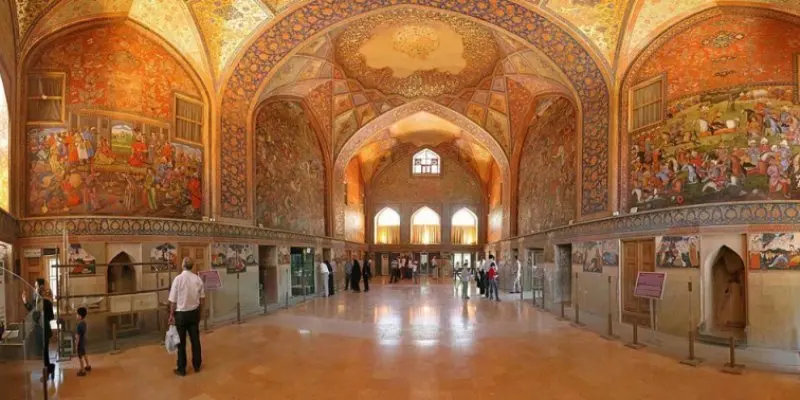
Embarking on a journey to explore Iran’s rich history and culture, one inevitably stumbles upon stunning monuments and beautiful palaces.
Of these, the Chehel Sotoun Palace stands as a distinct crown jewel. An emblem of Persian history and aesthetics, it narrates the tales of Iranian history in the language of art and architecture.
Why Visit Chehel Sotoun Palace
Often dubbed the “Palace of Forty Columns,” Chehel Sotoun offers a unique blend of Persian art and culture. Its magnificent mural paintings, reflecting mirrors, lush gardens, and rich cultural heritage, invite travelers from around the globe. It is not just an architectural spectacle but also an artistic masterpiece.
With its reflections on the waters of the courtyard pool, the palace presents an image of having forty columns. This optical illusion contributes to its intriguing name, Chehel Sotoun, which in Persian signifies forty pillars.
The 20 wooden columns of the entrance pavilion, doubled by their reflection, create the illusion of forty pillars, imbuing a sense of grandeur and offering visitors an unforgettable sight.
The Chehel Sotoun Palace offers a peek into Iran’s illustrious past. Its wall paintings and ceiling frescos depict significant historical events, royal receptions, and battle scenes. Each frame is a tale in itself, adding a layer to the rich tapestry of Iran’s past.
Location and Route
The Chehel Sotoun Palace is nestled amidst the historic city of Isfahan, Iran. It is conveniently located at the heart of the city, within the lush garden that extends to an area of 67,000 square meters.
Getting to the Chehel Sotoun Palace is quite straightforward. If you are already in Isfahan, you can take a taxi or a local bus to reach the palace. The city’s public transportation network is well-connected and cost-effective. The palace is also reachable by foot from the city center, offering a leisurely walk through the vibrant streets of Isfahan.
For those traveling from the capital, Tehran, multiple options are available. One can take a flight to Isfahan, a train, or a bus. The journey by road offers a scenic route that showcases Iran’s diverse landscapes.
When to Visit
Iran’s climate varies dramatically from region to region. Isfahan, where Chehel Sotoun is located, experiences a semi-arid climate, with hot summers and cold winters. Thus, the best times to visit the palace are during spring (April to June) and autumn (September to November). During these periods, the weather is mild and the gardens of the palace are in full bloom, enhancing the beauty of the site.
Another good time to visit the palace is during the Nowruz holidays, which mark the Iranian New Year. Celebrated at the beginning of spring, around late March, Nowruz brings with it a festive spirit, making your visit to the palace even more special.
What to See
The Chehel Sotoun Palace is a treasure trove of Persian art and culture. As you walk through the palace, there are several captivating sights that demand your attention:
1. Entrance Pavilion
The entrance pavilion or the mirror hall is a sight to behold. This part of the palace is where the illusion of forty columns takes birth. The wooden columns stand tall, reflecting off the water, and the detailed artwork on the ceiling promises to leave you spellbound.
2. Mural Paintings
The interior walls of the palace are adorned with beautiful mural paintings depicting various historical and mythical events. From the Battle of Chaldiran against the Ottoman Sultan Selim I to the reception of the Uzbek King Vali Mohammad Khan, these murals offer glimpses into the grandeur of Persian history.
3. Seven-Colored Tiles
The exterior of the palace is covered with seven-colored tiles, also known as Haft Rang tiles, a traditional form of Persian tilework. The tiles form intricate geometric patterns and floral designs, adding to the palace’s overall aesthetic appeal.
4. Gardens
The palace is surrounded by a vast Persian Garden, filled with tall plane trees and a large pool in the middle. The garden itself is a UNESCO World Heritage Site and offers a serene environment to relax and soak in the beauty of the palace.
5. Museum
The palace also houses a museum showcasing Persian artifacts, including ceramics, miniatures, and historic royal costumes. This museum gives visitors a deeper understanding of Persian art, culture, and history.
In conclusion, the Chehel Sotoun Palace is a testament to Iran’s glorious past. Its artistic splendor, lush gardens, and captivating history make it a must-visit destination for anyone intrigued by the allure of Persian culture. As you traverse through the magnificent palace, you are bound to be charmed by its grandeur and rich heritage.



